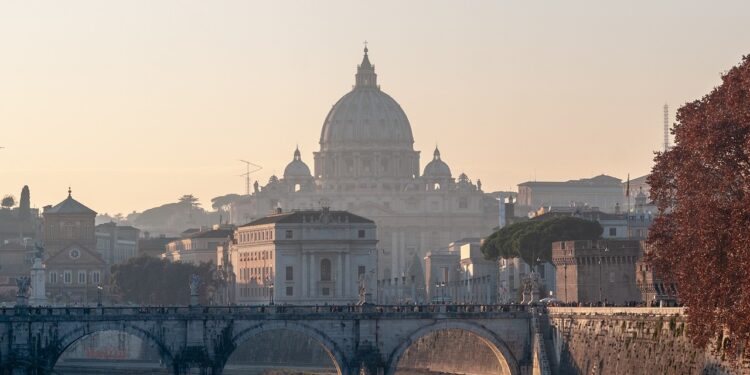Rome, the breathtaking capital of Italy, is one of the most historically and culturally rich cities in the world. With its ancient ruins, stunning architecture, and vibrant streets, it offers visitors an unforgettable experience. While some of the city’s top attractions come with a price tag, Rome also boasts a wealth of free things to do, ensuring that budget-conscious travellers can still immerse themselves in its rich history and charm. In this guide, VayCay Couple will take you through the best free attractions to visit in Rome, from must-see monuments to hidden gems, that allow you to experience the grandeur of the Eternal City without spending a cent.
The Colosseum and Roman Forum – Ancient Rome’s Heartbeat
The Colosseum is arguably the most recognizable symbol of Rome’s imperial grandeur, and while entering the amphitheatre requires a ticket, you can still marvel at its colossal exterior for free. The sheer scale of this ancient structure, once the scene of gladiatorial contests and public spectacles, is awe-inspiring. Take time to walk around the Colosseum and soak in its historical significance. Close by is the Roman Forum, the epicenter of ancient Roman life, where politicians, philosophers, and citizens once gathered. Walking through the Forum, with its crumbling columns and remnants of ancient temples, provides a window into the everyday life of ancient Rome. The best part? You can enjoy the Roman Forum from several viewpoints along the surrounding streets, making it a fantastic free attraction.
The Pantheon – Rome’s Architectural Masterpiece
The Pantheon is one of Rome’s most extraordinary buildings, both for its architectural ingenuity and for the fascinating history it holds. Originally built as a temple dedicated to all the gods of ancient Rome, it is now a functioning church. What makes the Pantheon truly remarkable is its enormous dome, which remains the largest unreinforced concrete dome in the world. At the centre of the dome is the oculus, a circular opening that lets natural light flood the building, creating a magical effect.
The Pantheon is also home to the tombs of several notable figures, including the artist Raphael. Best of all, entry is completely free, making it one of the most accessible attractions for those looking to experience ancient Roman architecture at its finest.
Piazza Navona – Baroque Beauty
One of the most picturesque squares in Rome, Piazza Navona is a must-visit for any traveler. The square is famous for its Baroque fountains, especially the Fountain of the Four Rivers, designed by Gian Lorenzo Bernini, which represents the four major rivers of the world. Surrounded by elegant buildings, churches, and restaurants, Piazza Navona offers an atmosphere that feels both historic and vibrant. Street artists, musicians, and performers often fill the square, creating a lively ambiance that is hard to resist. The best part about Piazza Navona is that you can wander through it, admire its fountains, and soak in the energy of the city entirely for free.
Trevi Fountain – A Legendary Landmark
The Trevi Fountain is one of the most iconic landmarks in Rome and a must-see for any visitor. This massive Baroque fountain, designed by Nicola Salvi, is not only a symbol of Roman art and architecture but also steeped in legend. According to tradition, if you toss a coin over your left shoulder into the fountain, you are guaranteed to return to Rome one day. Every day, thousands of tourists flock to the Trevi Fountain to admire its beauty and make their wish.
While it is stunning during the day, the fountain takes on a magical quality at night when it is illuminated, and the shimmering water reflects the surrounding architecture. Visiting the fountain is completely free, making it a perfect stop for budget-conscious travellers.
Spanish Steps – The Iconic Meeting Point
The Spanish Steps, with their elegant 18th-century design, are one of Rome’s most famous attractions. Located in the heart of the city, the steps connect Piazza di Spagna at the base with Trinità dei Monti church at the top. The steps are a popular meeting point for both locals and tourists, and during springtime, they are adorned with blooming azaleas, adding a vibrant splash of color to the scene. Climbing the 135 steps rewards visitors with panoramic views of Rome’s rooftops and bustling streets. It’s a great spot for people-watching and enjoying the lively atmosphere of the city. Best of all, it’s free to visit and experience this quintessential Roman landmark.
Consider exploring Rome from the Spanish Steps to the iconic Trevi Fountain.
Villa Borghese Gardens
If you’re looking to escape the busy streets and enjoy some greenery, the Villa Borghese Gardens offer the perfect retreat. This expansive park is home to beautiful walking paths, scenic lakes, and several small museums. Visitors can enjoy a leisurely stroll through the gardens, relax by the water, or have a picnic under the shade of ancient trees. The gardens also offer spectacular views of the city from the Pincian Hill, making it an ideal spot for photos. Whether you’re looking for a peaceful afternoon or a fun place to explore with children, Villa Borghese is one of the best free parks in Rome.
Janiculum Hill
Janiculum Hill offers one of the most stunning panoramic views of Rome. Located just west of the Tiber River, it’s a bit off the beaten path, but the hike up is well worth it. From the top, you can enjoy sweeping views of the city’s skyline, with iconic landmarks like the Pantheon and St. Peter’s Basilica in the distance. This is one of the best places in Rome to watch the sunset, and the experience is completely free. Near the summit, you’ll find the Fontana dell’Acqua Paola, a grand fountain that’s a sight in its own right. Whether you’re a photographer or just want to enjoy a peaceful moment, Janiculum Hill is a hidden gem worth visiting.
Santa Maria della Vittoria
If you’re an art enthusiast, don’t miss the chance to visit Santa Maria della Vittoria, a small church that houses one of Bernini’s greatest works, The Ecstasy of Saint Teresa. This Baroque masterpiece is a dramatic depiction of the saint in a moment of religious ecstasy, and the detail and craftsmanship are truly awe-inspiring. The church itself is small but richly decorated, with ornate frescoes and marble sculptures that make it a hidden treasure in Rome. Best of all, entrance is free, allowing you to experience world-class art without spending a dime.
Mouth of Truth in Rome (Bocca della Verità)
Legend has it that the Mouth of Truth in Rome can detect lies. This ancient marble mask is located in the portico of the church of Santa Maria in Cosmedin. It is a fun and quirky attraction. Visitors often line up to put their hands inside the mouth. This follows the tradition made famous by the movie “Roman Holiday.”
Piazza di Spagna Rome (Spanish Square)
Piazza di Spagna Rome, known for the Spanish Steps, is also home to the Barcaccia Fountain, designed by Bernini’s father, Pietro. The square is a bustling hub surrounded by designer boutiques and charming cafes.
Basilica of Santa Maria Maggiore
The Basilica of Santa Maria Maggiore is one of the largest and most important churches in Rome. Its grand façade and opulent interiors are a testament to the wealth and power of the Catholic Church in medieval times. Inside, visitors can marvel at the basilica’s stunning mosaics, which date back to the 5th century and depict scenes from the Bible. The ceilings are gilded with gold brought from the Americas, and the chapel contains impressive works of art. The basilica is free to enter, making it a must-see for anyone interested in religious history or Roman architecture.
Circus Maximus
The Circus Maximus was once the largest chariot racing stadium in the ancient world, capable of holding over 150,000 spectators. Today, it’s a vast open space where visitors can walk, jog, or simply relax while imagining the grandeur of ancient Roman spectacles. Although little remains of the original structure, the historical significance of the site makes it a fascinating place to explore. The grassy field offers a peaceful respite from the crowded city, and the nearby ruins of the Palatine Hill are visible from the site, adding to the sense of stepping back in time.
Piazza del Popolo
Piazza del Popolo is one of the grandest squares in Rome, located at the foot of the Pincian Hill. The square is flanked by twin churches and dominated by a towering Egyptian obelisk that was brought to Rome by Emperor Augustus. It’s a lively place, often filled with tourists, locals, and street performers, making it an excellent spot to soak up the city’s energy. From the Piazza del Popolo, you can easily access the nearby Villa Borghese Gardens, making it an ideal starting point for a leisurely stroll through one of Rome’s most beautiful green spaces. Whether you’re stopping to admire the architecture, people-watch, or just take in the historical significance of the area, Piazza del Popolo is a wonderful free attraction in Rome that offers a glimpse into the city’s past while embracing its vibrant present.
The Protestant Cemetery (Cimitero Acattolico)
For those looking for a more contemplative experience, the Protestant Cemetery, also known as the Cimitero Acattolico, is one of Rome’s hidden gems. This serene burial ground is the final resting place of famous poets such as John Keats and Percy Bysshe Shelley. The cemetery is beautifully landscaped, with towering cypress trees and lush greenery, providing a peaceful atmosphere that contrasts with the bustling city outside its walls. The tombstones, many of which are artistically carved, tell the stories of expatriates, artists, and intellectuals who found their final resting place here. A visit to the Protestant Cemetery offers not only a chance to pay homage to these literary figures but also an opportunity to reflect and appreciate the tranquil beauty of this unique site.
Summary
Rome is a city of endless wonders, and you don’t need to break the bank to enjoy its rich history and beauty. From iconic landmarks like the Colosseum and Pantheon to tranquil parks like Villa Borghese, there is an abundance of free attractions that allow you to explore the essence of Rome without spending a dime. Whether you’re a history buff, an art lover, or simply someone looking to soak in the charm of the Eternal City, Rome has something for everyone. By visiting these free sites, you’ll gain a deeper appreciation for the city’s ancient past and vibrant present, all while keeping your budget intact. So, pack your bags, bring your camera, and get ready to experience the best free attractions to visit in Rome with us, at VayCay Couple.
Additional Tips for Free Exploration in Rome
- Free Walking Tours: Several companies offer free walking tours of Rome that cover major sights like the Colosseum, Trevi Fountain, and Pantheon. While the tours are free, tips for the guides are encouraged.
- Free Museum Days: Keep an eye on the first Sunday of each month when many museums and archaeological sites in Rome offer free entry to the public. It’s a perfect opportunity to explore sites like the Roman Forum and the Capitoline Museums without paying an entrance fee.
- Explore Rome by Night: Many of Rome’s most iconic landmarks, such as the Trevi Fountain and Colosseum, are beautifully lit at night, offering a magical experience. Night time walks are a great way to see the city in a different light and enjoy its beauty without the crowds.














